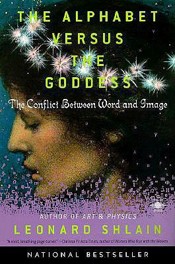The Alphabet Versus the Goddess: The Conflict Between Word and Image

Here’s the basic premise –
Images and writing are very different. They utilize different parts of the brain. Images are feminine, writing is masculine.
Images are perceived all at once, holistically – we step back and take in a visual scene, in aggregate. Writing, on the other hand, is sequential – we start at one word, and move word by word, slowly building meaning
The advent of writing in every society has coincided with a remarkable downturn in the fates of women in those societies. Literacy makes societies go a little crazy. Prior to writing, people freely worshiped goddesses and got along relatively well using the feminine parts of their brains. Then writing came along and we decided to abuse women and go to war.
Shlain goes on about this for 432 pages.
I’m not saying he’s wrong, but some of it gets far-fetched. To wit: a mushroom cloud is phallic, therefore the destruction of nuclear war is masculine. Also, dyslexia affects boys to girls in a 9:1 ratio, therefore it’s a neurosis caused by the problems associated with literacy.
The main part of the book is basically a long, historical survey of world religions. He covers them all. Some of it is compelling – the Protestant/Catholic wars were crazy – but a lot of it is just a long slog where he seems to walk away from his premise a bit. There are times where I was thinking, “Yeah, this is interesting, but what does it have to do with your central point?”
He’s certainly not against literacy (he’s a brain surgeon, so the man has been educated), but his claim is that we have devalued the image and we need to bring the two sides of our brain back in balance.
At the very end, Shlain implies that the world might be headed back to more imagery and less writing. The advent of the internet and more media are decried as reducing literacy, but there might actually benefits for society becoming more image-centric.
It’s an interesting premise, and he has a mountain of circumstantial evidence for it. Additionally, if you have any interest in the history of religion and belief, this is a great book for that – I find myself marveling that a brain surgeon had time to essentially become a historical theologian to boot.
I’m giving it four-stars primarily because it made me think. I don’t buy the entire premise, but he turned the gears in my head a bit and gave me a new, tiny facet through which to look at the world, and that’s something.
Book Info
- I have read this book. According to my records, I completed it on .
- A softcover copy of this book is currently in my home library.